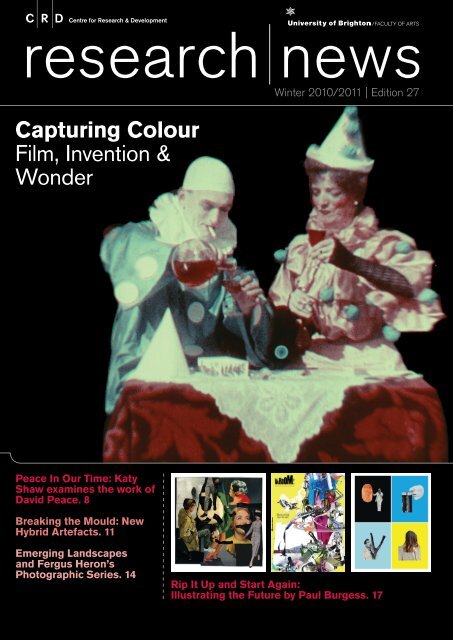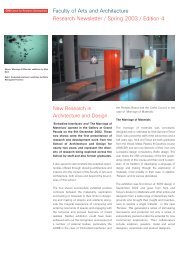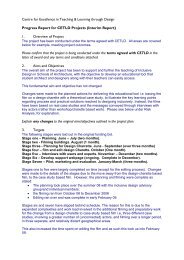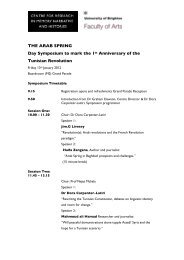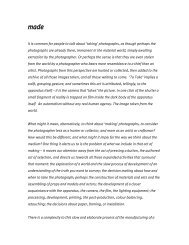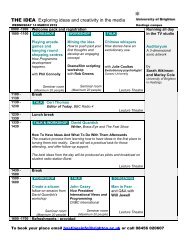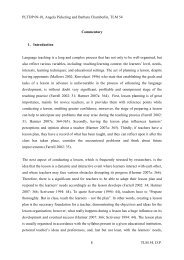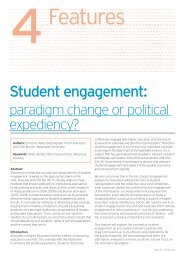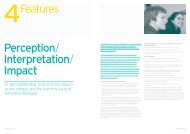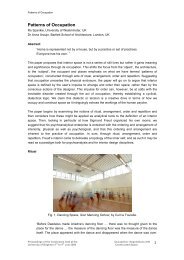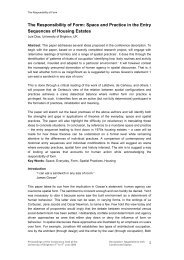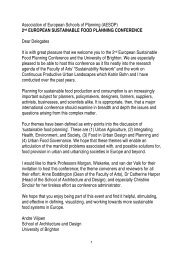Research News 27, Winter 2010/11 - University of Brighton - Faculty ...
Research News 27, Winter 2010/11 - University of Brighton - Faculty ...
Research News 27, Winter 2010/11 - University of Brighton - Faculty ...
Create successful ePaper yourself
Turn your PDF publications into a flip-book with our unique Google optimized e-Paper software.
s/FACULTY /FACULTY OF ARTS<br />
OF ARTS<br />
research news<br />
Capturing Colour<br />
Film, Invention &<br />
Wonder<br />
Peace In Our Time: Katy<br />
Shaw examines the work <strong>of</strong><br />
David Peace. 8<br />
Breaking the Mould: New<br />
Hybrid Artefacts. <strong>11</strong><br />
Emerging Landscapes<br />
and Fergus Heron’s<br />
Photographic Series. 14<br />
<strong>Winter</strong> <strong>2010</strong>/20<strong>11</strong> | Edition <strong>27</strong><br />
Rip It Up and Start Again:<br />
Illustrating the Future by Paul Burgess. 17
<strong>Winter</strong> <strong>2010</strong>/20<strong>11</strong> | Edition <strong>27</strong><br />
Contents<br />
<strong>News</strong> 03-05<br />
03 <strong>Research</strong> <strong>News</strong> Changing<br />
03 £164,000 Investment in the<br />
Digitisation <strong>of</strong> the SASE Collection<br />
03 Place, space and the art <strong>of</strong><br />
consumption<br />
Steven Miles <strong>Faculty</strong> Director <strong>of</strong><br />
Postgraduate Studies Inaugural Lecture<br />
04 PUMAVision<br />
Design Camp<br />
04 The House that Kevin Built<br />
Donations needed<br />
05 Knitting Communities in the Andes<br />
A case study<br />
05 Literature and Politics<br />
at <strong>Brighton</strong><br />
Higher Education Academy<br />
Features 06-20<br />
06 Capturing Colour<br />
Film, Invention & Wonder<br />
08 Peace in Our Time<br />
Katy Shaw examines the work <strong>of</strong> David<br />
Peace<br />
<strong>11</strong> Breaking The Mould<br />
New Hybrid Artefacts<br />
14 Emerging Landscapes<br />
by Fergus Heron<br />
17 Rip It Up and Start Again<br />
Illustrating the Future<br />
<strong>Research</strong> Student <strong>News</strong> 21-23<br />
21 Dispelling the Myth<br />
The influence <strong>of</strong> cinema on the fashion <strong>of</strong><br />
young, working-class women in the 1930s<br />
22 Issue <strong>of</strong> Diversity<br />
African and African-Caribbean Design<br />
Diaspora Project<br />
23 Performing Colonial Modernity<br />
A trans-disciplinary consideration<br />
23 The <strong>Research</strong> Student Division<br />
Welcomes<br />
24 <strong>Research</strong> Student Handbook<br />
<strong>2010</strong>/<strong>11</strong><br />
2<br />
Welcome to the first in our leaner on-line series <strong>of</strong><br />
<strong>Research</strong> <strong>News</strong>. To commence this fresh approach in<br />
this issue examples <strong>of</strong> research taking place in Schools<br />
across the <strong>Faculty</strong> <strong>of</strong> Arts are presented.<br />
Firstly, from the School <strong>of</strong> Arts & Media, Dr Frank Gray (Director <strong>of</strong> the Screen Archive<br />
South East) presents Capturing Colour: Film, Invention & Wonder, a body <strong>of</strong> archive<br />
material and an exhibition currently showing at <strong>Brighton</strong> Museum & Art Gallery. Dr<br />
Gray’s research focuses on the emergence <strong>of</strong> ‘colour’ in film in Britain from the late 19 th<br />
century to the 1930s.<br />
Moving from turn <strong>of</strong> the century to more recent history, Katy Shaw from the School <strong>of</strong><br />
Humanities returns to <strong>Research</strong> <strong>News</strong> with the launch <strong>of</strong> her new book David Peace:<br />
Texts and Contexts. She examines Peace’s ‘occult’ accounts <strong>of</strong> twentieth century<br />
living, his ability to rake over uncomfortable histories, <strong>of</strong> controversial people and<br />
contentious periods in order to create narratives that blend fact and fiction, and to<br />
evolve a unique understanding <strong>of</strong> our country’s past.<br />
From the School <strong>of</strong> Architecture & Design after two years <strong>of</strong> research and development<br />
with her commercial partners, Stratasys Fortus – Kelly Sant has succeeded in<br />
Breaking the Mould. Stemming from a mutual interest in the connection between<br />
digital manufacture and tissue engineering as a way to propagate sustainable forms,<br />
this practice-based research has led her team to develop a new hybrid technique<br />
combining the attributes <strong>of</strong> Rapid manufacture and the traditional mould making<br />
processes.<br />
After completing the first round <strong>of</strong> sabbaticals Fergus Heron has produced the<br />
Shopping Centre photographic series. Part <strong>of</strong> a wider research project that forms<br />
an extended inquiry towards new ways <strong>of</strong> seeing connections, discontinuities and<br />
tensions between the traditional and the modern. Heron’s photographs depict local<br />
commercial spaces where globally produced goods are consumed, proposing a way <strong>of</strong><br />
seeing modern interior urban spaces.<br />
Paul Burgess contemplates the revival <strong>of</strong> collage “the most democratic <strong>of</strong> art-forms”,<br />
interpreting this nostalgic and now ubiquitous style as the backlash against the slick<br />
and digital age and a reflection <strong>of</strong> our current climate.<br />
In <strong>Research</strong> Student news Cheryl Roberts Dispels the Myth, investigating the effect <strong>of</strong><br />
cinema on the fashion <strong>of</strong> young working women in the 1930s; Katherine Ladd steers<br />
a three-year initiative The African and African-Caribbean Design Disapora (AACDD),<br />
to highlight and ignite the creative potential and excellence in this sector; and Denise<br />
Gonyo’s early career research presents her Visions’ <strong>of</strong> India at Edinburgh’s Performing<br />
Colonial Modernity Conference.<br />
We hope you enjoy this issue <strong>of</strong> <strong>Research</strong> <strong>News</strong>.<br />
The CRD Editorial Group<br />
research news<br />
Capturing Colour<br />
Film, Invention &<br />
Wonder<br />
s/FACULTY /FACULTY OF ARTS OF ARTS<br />
<strong>Winter</strong> <strong>2010</strong> | Edition <strong>27</strong><br />
Peace In Our Time: Katy<br />
Shaw examines the work <strong>of</strong><br />
David Peace. 8<br />
Breaking the Mould: New<br />
Hybrid Artefacts. <strong>11</strong><br />
Emerging Landscapes<br />
Fergus Heron’s Rip It Up and Start Again:<br />
e Future by Paul Burgess. 17<br />
Cover image<br />
Two Clowns, G. A. Smith, 1906. Black<br />
& white Kinemacolor print from British<br />
Film Institute, re-constructed by<br />
Screen Archive South East. Page 6.<br />
Illustration credits: the illustrations in this publication have been provided<br />
by institutions/individuals each <strong>of</strong> which is identified in the caption to<br />
their illustration. Copyright restrictions in favour <strong>of</strong> each institution/<br />
individual apply. In the case <strong>of</strong> some it has not been possible to trace the<br />
copyright holder, but it is hoped that in any cases where this may have<br />
happened, the copyright holder will be pleased with the results.
NEWS<br />
<strong>Research</strong> <strong>News</strong><br />
Changing<br />
Further to our annual review we are<br />
announcing some changes to <strong>Research</strong><br />
<strong>News</strong>, with the aim <strong>of</strong> increasing quality<br />
and publishing news and articles in a more<br />
efficient and cost effective manner.<br />
NUMBER OF ISSUES<br />
• <strong>Research</strong> <strong>News</strong> will now be published<br />
twice a year, one issue per semester.<br />
CONTENT<br />
• The magazine will focus on detailed<br />
research content rather than news, with<br />
more pages dedicated to 500-1,500<br />
word articles detailing recent research<br />
by staff.<br />
• <strong>News</strong> items will be directly published on the<br />
Centre for <strong>Research</strong> and Development’s<br />
website to enhance the speed <strong>of</strong> their<br />
dissemination. <strong>Research</strong> <strong>News</strong> will feature<br />
a summary <strong>of</strong> news items with links to the<br />
CRD website.<br />
• Conferences and events information<br />
will be circulated via email and/or on the<br />
website to enhance their currency and the<br />
speed <strong>of</strong> their dissemination.<br />
• <strong>Research</strong> <strong>News</strong> will also continue to<br />
publish material to the faculty research<br />
website.<br />
DISTRIBUTION<br />
• <strong>Research</strong> <strong>News</strong> will now be sent as a PDF<br />
via email, although a limited amount <strong>of</strong><br />
printed copies can be made available on<br />
request.<br />
DEADLINES FOR COPy<br />
This academic year’s copy deadlines for your<br />
diary are:<br />
• Semester Two – Friday 25 March 20<strong>11</strong><br />
To reflect the focus on detailed research<br />
content rather than news, the editorial group<br />
is working on a new title.<br />
Please do not hesitate to send Sara Duffy<br />
(sd164@brighton.ac.uk) items <strong>of</strong> news<br />
related to your research activity as she will<br />
continue to publish them on the web as well<br />
as collect them for possible publication in<br />
<strong>Research</strong> <strong>News</strong>.<br />
s/FACULTY OF ARTS<br />
£164,000 Investment in the<br />
Digitisation <strong>of</strong> the SASE Collection<br />
In the summer <strong>of</strong> <strong>2010</strong>, Screen Archive<br />
South East was awarded £164,000 to<br />
preserve, catalogue and digitise selected<br />
films in its collection. The funding was<br />
awarded by Screen Heritage UK, the<br />
organisation established in 2007 to both<br />
award and administrate new investment in<br />
the English Screen Heritage Collections.<br />
An important aspect <strong>of</strong> this new SASE<br />
project, which will conclude in June 20<strong>11</strong>,<br />
is digitisation.<br />
The SASE collection consists largely <strong>of</strong> film<br />
but we now live in a digital age. Digitisation<br />
(copying to a digital carrier) is therefore the<br />
key to being able to make effective and<br />
efficient public use <strong>of</strong> the public heritage<br />
in SASE’s care. Digitisation also implies a<br />
range <strong>of</strong> processes that need to be carried<br />
out every day in order to meet access<br />
needs. These processes include; film-todigital<br />
transfer creating uncompressed HD<br />
files (digital archive masters); restoration <strong>of</strong><br />
access versions <strong>of</strong> these files (colour grading,<br />
speed and frame correction, picture and<br />
sound cleaning); creation <strong>of</strong> access copies<br />
on authored dvds for donors, depositors,<br />
Place, space and the<br />
art <strong>of</strong> consumption<br />
Steven Miles <strong>Faculty</strong><br />
Director <strong>of</strong> Postgraduate<br />
Studies Inaugural Lecture<br />
The subject <strong>of</strong> consumption became a focus<br />
for considerable academic attention in the<br />
1990s when many commentators recognised<br />
that, potentially at least, consumption was<br />
more than just a trivial arena <strong>of</strong> self-exploration.<br />
Despite its ten minutes <strong>of</strong> fame, critical<br />
engagement with consumption has never<br />
been fully crystalised. The status quo is such<br />
that the arena <strong>of</strong> consumption has largely been<br />
condemned to sitting on the fringes <strong>of</strong> serious<br />
critical debate; apparently a preoccupation<br />
<strong>of</strong> postmodernists and right-wing apologists.<br />
In Miles’ presentation it is suggested that,<br />
whether we like it or not and regardless<br />
<strong>of</strong> the environmental consequences, the<br />
experience <strong>of</strong> consumption continues to<br />
lay at the very heart <strong>of</strong> contemporary social<br />
and cultural life and, as such, deserves more<br />
serious attention in both the social sciences<br />
and the arts. The actions <strong>of</strong> consumers are<br />
all too easily condemned both on a social and<br />
an intellectual level. The consumer should<br />
not then be condemned or indeed pitied for<br />
he or she gladly dances to the tune that the<br />
consumer society has chosen.<br />
Inaugural lecture takes place on: 13 th<br />
Jan 20<strong>11</strong> 6:30pm. Sallis Benney Theatre.<br />
ht tp: //ar tsresearch.brighton.ac.uk /<br />
research/academic/miles/<br />
presentations and distribution; creation <strong>of</strong><br />
encoded versions for online use and other<br />
versions as required (e.g. MPEG4, QuickTime<br />
and DVCam); storage <strong>of</strong> masters and<br />
compressed access surrogates in secure<br />
digital stores.<br />
Investment in digitisation is therefore<br />
essential in order to modernise the digital<br />
capabilities <strong>of</strong> SASE, ensuring that we can<br />
meet the needs <strong>of</strong> all <strong>of</strong> our users. The ambition<br />
is that this project will provide the archive with<br />
a new digital foundation that is both sensible<br />
and sustainable.<br />
3 researchnews<br />
NEWS
PUMAVision<br />
Design Camp<br />
Dr Chapman was approached by the leading<br />
sports lifestyle brand PUMA, to consult on<br />
strategic and creative approaches that embed<br />
sustainability more centrally within their design<br />
process.<br />
In July <strong>2010</strong>, Dr Chapman presented his<br />
research and findings at the ‘PUMA Design<br />
Camp,’ an annual event held at the PUMAVision<br />
HQ (Nuremberg, Germany) in which the<br />
entire PUMA design force <strong>of</strong> 130 (across all<br />
product sectors) come together to explore and<br />
exchange ideas that will define the creative<br />
direction for the forthcoming year. Following<br />
Dr Chapman’s presentation, Hussein Chalayan,<br />
PUMA’s Creative Director, delivered the 20<strong>11</strong>-<br />
12 Macro Direction for PUMA followed by<br />
presentations on communication objectives,<br />
brand concept, colour and trend.<br />
As a forward-thinking brand leader, PUMA<br />
have recently committed to ‘the long-term aim<br />
<strong>of</strong> being the most desirable and sustainable<br />
sports lifestyle company in the world’. PUMA<br />
The House<br />
that Kevin<br />
Built<br />
Donations<br />
needed<br />
<strong>Brighton</strong> and Hove City Council has granted<br />
planning permission for the <strong>University</strong> <strong>of</strong><br />
<strong>Brighton</strong> to rebuild The House That Kevin Built,<br />
a house <strong>of</strong> the future that captivated millions<br />
<strong>of</strong> TV viewers who watched its construction.<br />
The house was erected in London’s<br />
Docklands live on Thames TV in six days in<br />
2008 for Channel 4’s Grand Designs Live<br />
and was heralded as the UK’s first lowenergy<br />
prefabricated house made from eco-<br />
4<br />
state that: ‘[w]e are<br />
committed to working in<br />
ways that contribute to<br />
the world by supporting<br />
creativity, sustainability<br />
and peace and by staying<br />
true to the values <strong>of</strong> being Fair, Honest,<br />
Positive and Creative in decisions made and<br />
actions taken. The foundation for our activities<br />
is PUMAVision – a concept that we intend to<br />
guide our work with its three core programs:<br />
puma.creative, puma.safe and puma.peace.<br />
Sustainability as an integral part <strong>of</strong> PUMA’s<br />
corporate strategy (from logistics, retail,<br />
product design, marketing and the overall<br />
reduction <strong>of</strong> waste and energy in buildings<br />
through examining and changing their<br />
approach to work) having recently developed<br />
what they call the ‘S-Index’ (Sustainability<br />
Index); a set <strong>of</strong> criteria for products that<br />
is PUMA’s interpretation <strong>of</strong> what should<br />
constitute best practice in sustainability.<br />
friendly materials.<br />
The house was later dismantled but the<br />
concept is being reborn in the courtyard <strong>of</strong> the<br />
<strong>University</strong>’s <strong>Faculty</strong> <strong>of</strong> Arts in Grand Parade,<br />
<strong>Brighton</strong>. Kevin McCloud, the British designer,<br />
is backing the idea along with <strong>Brighton</strong> &<br />
Hove City Council and the Building <strong>Research</strong><br />
Establishment (BRE), the construction industry’s<br />
research and consultancy organisation.<br />
The house was designed by architect Duncan<br />
Puma Design HQ Nuremberg, Germany<br />
Their aim is that 50% <strong>of</strong> its international<br />
product collections in footwear, apparel and<br />
accessories and 100% <strong>of</strong> its packaging are<br />
‘S-index’ approved by 2015.<br />
In addition to future consultancy, PUMA<br />
and the <strong>University</strong> <strong>of</strong> <strong>Brighton</strong> are currently<br />
exploring links in terms <strong>of</strong> student internships,<br />
work placements and setting up live projects<br />
with students across the faculty. This is a<br />
specific type <strong>of</strong> engagement that will look to<br />
develop meaningful opportunities for individual<br />
learners, in all subject areas, who place<br />
sustainability as a key driver to their work.<br />
http: /artsresearch.brighton.ac.uk/research/<br />
academic/chapman<br />
Baker-Brown, senior<br />
lecturer in architecture at<br />
the <strong>University</strong>’s <strong>Faculty</strong> <strong>of</strong><br />
Arts and also a director <strong>of</strong><br />
BBM Sustainable Design.<br />
Duncan is working with the<br />
<strong>University</strong>’s Development<br />
and Alumni <strong>of</strong>fice to find the<br />
supporters who are needed<br />
to help raise £300,000<br />
required to build the house.<br />
The <strong>University</strong>’s development<br />
manager, Andrew<br />
Scanlan, is managing<br />
the fundraising effort. All<br />
donations to the <strong>University</strong><br />
are eligible for both Gift<br />
Aid and the government’s matched funding<br />
scheme; for every £2 we receive in<br />
philanthropic donations we can claim an<br />
additional £1 from the government. With both<br />
gift aid and matched funding.<br />
If you would like to make a donation to<br />
the project visit http://arts.brighton.ac.uk/<br />
research/sustainability-network/the-housethat-kevin-built.
Knitting Communities in the Andes –<br />
A case study<br />
Literature and Politics<br />
at <strong>Brighton</strong><br />
Higher Education Academy<br />
In September, Humanities at Falmer hosted<br />
a Higher Education Academy study day on<br />
the teaching <strong>of</strong> literature and politics in 21st<br />
Century Higher Education. The day aimed<br />
to explore some <strong>of</strong> the shifts, trends and<br />
developments in the field and its relationship<br />
to teaching and research in contemporary<br />
universities. Many <strong>of</strong> the debates which have<br />
shaped current literary theory and literature<br />
courses belong to the period <strong>of</strong> the 1960s and<br />
1970s. Yet structuralism and post-structuralism,<br />
modernism and post-modernism, Empire and<br />
post colonialism, women’s writing and postfeminism<br />
are also concepts which have shaped<br />
the contemporary curriculum. While many<br />
academics were trained in a context where<br />
the theoretical frame owed much to the work<br />
In November <strong>2010</strong>, Toni Hicks<br />
and Dr. Joan Farrer presented<br />
a poster to The Textile Institute<br />
Centenary Conference in<br />
Manchester.<br />
The poster shows images<br />
from several indigenous<br />
knitting communities in Peru<br />
and Bolivia highlighting the<br />
fine balance required to enable<br />
the development <strong>of</strong> their skills<br />
to make products for a wider<br />
market whilst preserving their<br />
heritage.<br />
Andean knitters possess<br />
inherent creative skills that have<br />
been refined over centuries.<br />
The need to re endorse the<br />
connection with their culture to<br />
perpetuate Andean traditional<br />
knitting, exhibiting significant<br />
mastery <strong>of</strong> stitch and structure<br />
to establish markets and<br />
create a sustainable industry<br />
is critical. Currently the Andean<br />
communities’ attitude towards<br />
their knit textile work is one <strong>of</strong><br />
economic necessity, compared<br />
with that <strong>of</strong> the leisure and<br />
Art House knitters in the<br />
developed world.<br />
emerging out <strong>of</strong> the movements <strong>of</strong> the 1960s,<br />
their students have no such history. <strong>University</strong><br />
staff today are teaching students for whom the<br />
fall <strong>of</strong> the Berlin wall, the 1984-5 miners’ strike,<br />
Thatcherism, Reaganism and the women’s<br />
movement are historical phenomena. Over<br />
the course <strong>of</strong> this one day event, academics,<br />
students and educationalists sought to explore<br />
the relevance <strong>of</strong> these arguments, that were<br />
once so fierce in literature and cultural studies,<br />
in today’s Coalition Britain. As educational<br />
policy moves towards the teaching <strong>of</strong> skills sets<br />
and research is required to have social ‘impact’,<br />
the conference also discussed the politics<br />
<strong>of</strong> teaching literature and how the curriculum<br />
should deal with political texts.<br />
Pr<strong>of</strong> Stuart Laing opened proceedings with<br />
a reflective analysis <strong>of</strong> changes in the teaching<br />
<strong>of</strong> political texts over his time as a lecturer,<br />
while visiting academics Dr Adam Hansen<br />
and Zacharoula Christopouou explored the<br />
influence <strong>of</strong> conflict and the British National<br />
s/FACULTY OF ARTS<br />
Staff Papers<br />
● Vikki Haffenden delivered ‘Women’s<br />
knitwear for a ‘growing’<br />
population. Digital Knit to Fit;<br />
challenges and solutions in<br />
fashion knitwear for larger sizes’<br />
At the Global Fashion: Creative<br />
and Innovative Contexts, Centre for<br />
Population, Economic and Social<br />
Studies, on <strong>11</strong>th-13th November <strong>2010</strong>,<br />
at the <strong>University</strong> <strong>of</strong> Oporto, Portugal.<br />
Avaiable online<br />
● Catherine Harper, Head <strong>of</strong> School,<br />
School <strong>of</strong> Architecture and Design,<br />
delivered ‘Abomination as a dress<br />
choice: the monstrous and the<br />
uncanny in the ‘intimate apparel’.<br />
Fashion in Fiction Conference, Drexel<br />
<strong>University</strong>, Philadelphia, October <strong>2010</strong><br />
Available online<br />
● Jean Martin, Digital Music and Sound<br />
Arts department delivered a paper<br />
at the Music and the Moving Image<br />
Conference in New York, 21-23 May<br />
<strong>2010</strong>. The research into film sound was<br />
condensed into a paper, which will be<br />
published in an extended version as a<br />
book chapter: “Being there – Sound<br />
design for documentary films.”<br />
In: Jong, Wilma de, Jerry Rothwell,<br />
and Erik Knudsen, (ed.), Creative<br />
Documentary: Theory and Practice<br />
(1 edn., Harlow: Longman, 20<strong>11</strong>).<br />
Party on the teaching <strong>of</strong> canonical literary texts<br />
in their own institutions. Dr Katy Shaw and<br />
Pr<strong>of</strong> Deborah Philips <strong>of</strong>fered insights into the<br />
relationship between contemporary politics and<br />
literary form while Dr Paddy Maguire and Pr<strong>of</strong><br />
Gina Wisker interrogated representations <strong>of</strong><br />
race, class and gender in literature and politics<br />
across the twentieth century and into the twenty<br />
first. The study day was hailed as a significant<br />
point in the ongoing negotiation <strong>of</strong> literature and<br />
politics in Higher Education by HEA director<br />
Nicole King. King praised the Literature team at<br />
<strong>Brighton</strong> for their innovative single hons degree,<br />
suggesting it <strong>of</strong>fers a significant engagement<br />
between literature and the local community as<br />
well as making an important stand against the<br />
depoliticisation <strong>of</strong> the subject and its teaching<br />
in contemporary Britain. Educationalists, policy<br />
makers, literature tutors and students made<br />
this a very successful day and a publication<br />
<strong>of</strong> the conference proceedings is currently in<br />
progress.<br />
5 researchnews<br />
NEWS
Dr Frank Gray has spent the last year curating the exhibition<br />
‘Capturing Colour: Film, Invention & Wonder’ for <strong>Brighton</strong> Museum &<br />
Art Gallery. Made possible with funding from the UK Film Council’s<br />
Digital Film Archive Fund and an AHRC Knowledge Transfer<br />
Fellowship, the project is devoted to the creation <strong>of</strong> this exhibition<br />
and a related programme <strong>of</strong> events on the emergence <strong>of</strong> ‘colour’ in<br />
film in Britain from the late 19 th Century to the 1930s. It is designed<br />
to enable the public to discover the wonder, beauty and history <strong>of</strong> this<br />
chromatic revolution as it evolved. As such it is designed to take this<br />
relatively unknown history (the story <strong>of</strong> coloured and colour film) and<br />
‘unpack’ it for public consumption through a carefully structured and<br />
crafted programme <strong>of</strong> activities designed to educate, fascinate and<br />
inspire. The exhibition will have a particular focus on <strong>Brighton</strong> & Hove<br />
because it was here that an important early film culture was based<br />
and it produced the first ‘colour’ motion pictures (Kinemacolor). As<br />
a knowledge transfer programme, it has been designed and is being<br />
delivered through structured interactions between Dr Gray (as the<br />
Knowledge Transfer Fellow), Screen Archive South East (SASE) and<br />
Royal Pavilions & Museums, <strong>Brighton</strong> & Hove (RP&M).<br />
The exhibition’s content has been drawn from SASE (lantern slides,<br />
6<br />
Two Clowns,G. A. Smith, 1906. Black & white<br />
Kinemacolor print from British Film Institute,<br />
re-constructed by Screen Archive South East<br />
Capturing Colour<br />
Film, Invention & Wonder<br />
16mm apparatus, colour films made on Dufaycolor and Kodachrome),<br />
<strong>Brighton</strong> & Hove Museums (a Kinemacolor camerae, hand-coloured<br />
photographs, lantern slides, Ives’ projecting Kromskop, tinted postcards,<br />
and the Kinemacolor collection), the British Film Institute (early European<br />
films in colour including Kinemacolor, Friese-Greene’s Biocolour and<br />
key examples <strong>of</strong> Technicolor) and the National Media Museum (notably<br />
the Charles Urban papers, autochromes, early colour film apparatus<br />
and early colour photographs especially Otto Pfenninger’s tricolour<br />
photographs <strong>of</strong> <strong>Brighton</strong>).<br />
Dr Gray’s work as an early film historian and as the Director <strong>of</strong><br />
Screen Archive South East, provides the research context for this new<br />
KT enterprise. For many years Gray has investigated systematically the<br />
cultural, economic and technological histories <strong>of</strong> early film production<br />
and consumption in <strong>Brighton</strong> and Hove from 1895-1914 through articles,<br />
contributions to major reference publications, conference papers and<br />
the curation <strong>of</strong> museum exhibitions and film festival programmes.<br />
<strong>Research</strong> for the exhibition began with looking at colour before film.<br />
From the invention <strong>of</strong> the first printing presses and the techniques <strong>of</strong><br />
engraving and etching in the 15 th Century, different versions would be<br />
produced for particular books and prints: one plain (uncoloured) and
The young Children <strong>of</strong> Brittany, Pathe,<br />
1909. Stencil-coloured film from the<br />
British Film Institute<br />
one coloured. The coloured version was always more desirable and, not<br />
surprisingly, the more expensive. The mid-to-late nineteenth century<br />
witnessed a range <strong>of</strong> new media technologies and printing processes<br />
that enabled the mass reproduction <strong>of</strong> books, pictures and projected<br />
images. Through photography, the magic lantern, newspapers,<br />
magazines, posters and books - pictures were everywhere. However<br />
black and white was still the standard form for most <strong>of</strong> these reproduced<br />
images.<br />
These technologies could not easily represent colour yet there<br />
continued to be a popular appetite for colour. To meet this need,<br />
coloured editions <strong>of</strong> books, prints, photographs, stereograms and<br />
lantern slides were produced. Both hand-colouring and complicated<br />
mechanical methods such as chromolithography were employed,<br />
depending on the medium. This coloured imagery ranged in quality but<br />
it all reflected the added value <strong>of</strong> being in colour.<br />
From this wider context, film and related activity in <strong>Brighton</strong> & Hove<br />
provides an important focus. Around 1900, there was a significant<br />
centre for the new vision technologies <strong>of</strong> colour film and colour<br />
photography here. In Hove lived G. Albert Smith and James Williamson,<br />
who each established a film studio and made innovative films that<br />
were seen throughout the world. It was here that Smith also began<br />
his Kinemacolor experiments. In <strong>Brighton</strong>, the house at 20 Middle<br />
Street served as a colour ‘research centre’. Here Captain William<br />
Davidson and Dr Benjamin Jumeaux ran their Tri-colour photographic<br />
printing business and conducted their experiments onto colour film<br />
and photography. Otto Pfinninger used their system to take his colour<br />
photographs <strong>of</strong> <strong>Brighton</strong> beach in 1906.<br />
Kinemacolor had genuine international success. It was the first<br />
commercially successful colour motion picture process and was<br />
heralded a genuine technological triumph <strong>of</strong> the Edwardian era.<br />
Smith’s additive system had a colour filter wheel on the camera and<br />
on the projector with only two primary colours – red and green. When<br />
Scottish Tartan, G. A. Smith, 1906. Black & white<br />
Kinemacolor print from British Film Institute, reconstructed<br />
by Screen Archive South East<br />
s/FACULTY OF ARTS<br />
projected, the alternating red and green tinted frames were combined<br />
by the eye to create a coloured image. The absence <strong>of</strong> blue was<br />
compensated for by the fact that some blue was recorded through the<br />
green filter. Charles Urban, who financed the system’s development,<br />
presented the first public screening on 1 May 1908 in London and a<br />
year later a selection <strong>of</strong> Kinemacolor films opened as an act within the<br />
nightly programme <strong>of</strong> the Palace Theatre <strong>of</strong> Varieties in London. It ran<br />
successfully for eighteen consecutive months and featured films <strong>of</strong> the<br />
<strong>Brighton</strong> seafront, sailing at Southwick and the carnival at Nice.<br />
Urban then leased the Scala Theatre on Charlotte Street, London,<br />
and from 19<strong>11</strong> to 1914 it provided Kinemacolor with its permanent<br />
London home. To visit the Scala was to see an all colour Kinemacolor<br />
programme with live music and a lecturer. Hundreds <strong>of</strong> fiction and nonfiction<br />
Kinemacolor films were made with studios at Hove and Nice,<br />
and Kinemacolor cinemas opened across the country. The greatest<br />
triumph for Kinemacolor was its film <strong>of</strong> the Delhi Durbar <strong>of</strong> 19<strong>11</strong>. In<br />
<strong>Brighton</strong>, a new cinema opened in May 19<strong>11</strong> - the Academy Cinema on<br />
West Street - and it was devoted exclusively to the exhibition <strong>of</strong> films<br />
in Kinemacolor.<br />
However Kinemacolor, like so many <strong>of</strong> the early colour processes,<br />
was short lived. Its long-term economic viability was challenged<br />
because not enough cinema managers were interested in purchasing<br />
the dedicated Kinemacolor projectors. More seriously, its patents<br />
were declared invalid in 1915 after a lengthy court battle. The arrival<br />
<strong>of</strong> Technicolor in the mid-1930s was the next major moment in this<br />
history – and for cinemas this was a remarkable new system because<br />
the colours were stunning and technically it was very simple to use as<br />
a Technicolor film could be played on any projector.<br />
‘Capturing Colour: Film, Invention & Wonder’ is at <strong>Brighton</strong> Museum<br />
& Art Gallery from 4 December <strong>2010</strong> to 20 March 20<strong>11</strong>. A parallel<br />
programme <strong>of</strong> events dedicated to colour was also part <strong>of</strong> <strong>2010</strong>’s<br />
CINECITY – the <strong>Brighton</strong> Film Festival.<br />
7 researchnews<br />
FEATURES
ce:<br />
ation<br />
0 – 6pm<br />
Parade<br />
ppearance by award<br />
avid Peace.<br />
ing Quartet, The Damned<br />
view with author readings<br />
are strictly limited.<br />
n.ac.uk.<br />
rature.<br />
8<br />
Peace in Our Time<br />
Katy Shaw examines the<br />
work <strong>of</strong> David Peace
From Premier League football and police politics to Noh drama and<br />
industrial disputes, the novels <strong>of</strong> David Peace <strong>of</strong>fer ‘occult’ accounts<br />
<strong>of</strong> twentieth-century history. Since the publication <strong>of</strong> his first novel<br />
in 1999, Peace’s work has quickly achieved critical acclaim. In 2003<br />
Granta magazine named him as one <strong>of</strong> their ‘Best Young Novelists’<br />
alongside rising stars <strong>of</strong> contemporary British literature including<br />
Monica Ali, Sarah Waters and Philip Hensher. To date he has won the<br />
Awards Cognac Prix du Roman Noir in 2002, the James Tait Black<br />
Award in 2004 and the Deutscher Krimi Preis in 2006. In 2007<br />
Peace was named GQ ‘Writer <strong>of</strong> the Year’, while media broadcaster<br />
and literary personality Melvyn Bragg claims that Peace is ‘one <strong>of</strong> the<br />
strongest voices in contemporary British fiction’ today.<br />
In recent years Peace’s work has also been translated onto television<br />
and film. British broadcaster Channel 4 adapted his Red Riding Quartet<br />
- based on the hunt for the Yorkshire Ripper - into a trilogy that aired in<br />
March 2009 and went on to achieve a theatrical release in America. In<br />
the same year, Peace’s novel about the rise and fall <strong>of</strong> British football<br />
legend Brian Clough, The Damned United, was adapted into a film<br />
featuring Frost/Nixon and The Queen star Michael Sheen. This trend <strong>of</strong><br />
translation into film and television looks set to continue, with production<br />
companies in the UK and Japan expressing interest in adapting his 2004<br />
tribute to the 1984-5 miners’ strike, GB84, as well as his most recent<br />
Tokyo Trilogy, exploring the reconstruction years in post-war Japan.<br />
Raking over uncomfortable histories, the canon <strong>of</strong> David Peace<br />
deliberately examines controversial people and contentious periods.<br />
Operating at the interface <strong>of</strong> fact and fiction, his texts break the<br />
surface <strong>of</strong> received histories, <strong>of</strong>fering dense, noir-driven analyses <strong>of</strong> the<br />
contemporary world. Addressing the many and contradictory demands<br />
<strong>of</strong> history, reality, truth and causality, as well as the confusions and<br />
debates that mask the power operating beneath overarching historical<br />
narratives, Peace’s novels bleed fact into fiction as part <strong>of</strong> a wider<br />
move towards an evolving understanding <strong>of</strong> the past.<br />
HIS DARK MATERIALS<br />
Although David Peace claims to ‘write novels not history’, the past and<br />
its relationship to the present underpins his work. Fostering a critical<br />
historical consciousness, his novels attempt to highlight the fictional<br />
nature <strong>of</strong> the present and in doing so ‘reveal’ crucial ‘hidden histories’.<br />
Through this intersection <strong>of</strong> past and present, attention is drawn to<br />
the great number <strong>of</strong> historical possibilities and possible histories that<br />
lie just below the surface <strong>of</strong> received accounts. In Peace’s novels the<br />
past is not comprised <strong>of</strong> hard facts but a great number <strong>of</strong> knowable<br />
histories, invented, overlooked, destroyed, denied or disregarded.<br />
Sourced in a belief that ‘fiction can illuminate a time and a place<br />
more clearly than fact’, the value <strong>of</strong> Peace’s fiction comes from its<br />
celebration <strong>of</strong> plurality and lack <strong>of</strong> conclusions. In refusing to seal<br />
<strong>of</strong>f the past hermeneutically, his novels remind readers <strong>of</strong> the lack <strong>of</strong><br />
certainty and limitations in our thinking about history, as well as how<br />
people are defined by their perceptions <strong>of</strong> the past. The past continues<br />
to assert itself in Peace’s work through a half-presence, a recognized<br />
and familiar but also strange and unknown bearing. Contesting the<br />
monolithic narratives <strong>of</strong>fered by existing histories, his novels establish<br />
alternative relationships between time frames, echoing Jean-Francois<br />
Lyotard’s claim that long-range metanarratives <strong>of</strong> the past are<br />
increasingly rejected in favour <strong>of</strong> local, individualised accounts.<br />
Peace <strong>of</strong>fers the novel form as a contested site in which images <strong>of</strong><br />
the past, as Walter Benjamin suggests, merely ‘flit by’ and refuse to be<br />
‘fixed’ by the centripetalizing forces <strong>of</strong> either fact or fiction. In his own<br />
s/FACULTY OF ARTS<br />
fictions, Peace does not turn to the past neutrally or <strong>of</strong>fer history as a<br />
consensus. Combating the fallout from a post-historical age, his novels<br />
transport the recent past from a commodity to be consumed into a<br />
period that is constantly being re-examined by contemporary society.<br />
Peace describes his openly partisan approach to re-creating the past as:<br />
trying to place my own ‘memories’ against what actually<br />
happened according to the papers – and it’s not only the news<br />
and the politics but every single detail from the weather, to the<br />
TV, to the gold mine that you can find in the classified adverts<br />
and personal columns. At the same time I am working at the<br />
library, I am also reading the ‘factual’ books on the subject [<br />
… ] Anyway once I have these basic photocopies and notes,<br />
I don’t leave the room anymore. I just hole myself up in there,<br />
submerged in a particular period I have chosen. I also have<br />
the music from the period playing and watch the films [ … ]<br />
I think that this ‘cultural’ research helps with the detail and<br />
the language, which has changed and continues to change<br />
dramatically. 1<br />
Reflecting on well-documented pasts through heavily researched<br />
analysis and personal reflection, Peace’s narratives are imbued with<br />
a depth <strong>of</strong> cultural materialism that positions his characters and their<br />
beliefs not as radical, but as symptomatic <strong>of</strong> the worlds presented.<br />
Engaging with the many cultural and social forces <strong>of</strong> these periods,<br />
Peace explores transitional times through the blurring <strong>of</strong> the historical<br />
and fictional. His claim that ‘everything is political’ underscores this<br />
approach. Taking unnerving perspectives on familiar events and<br />
public figures, his novels do not seek to oppose or transcend existing<br />
historical accounts, but to heterodox them with new narratives to <strong>of</strong>fer<br />
sometimes contradictory ways <strong>of</strong> reconfiguring the events in question.<br />
With the exception <strong>of</strong> his Tokyo Trilogy, Peace’s fictions concentrate<br />
on the history <strong>of</strong> the UK during the 1970s and 1980s. As seen through<br />
the prism <strong>of</strong> Peace, this period is transformed into a new context in<br />
which other pasts can be read. While the 1960s have been popularly<br />
regarded as a time <strong>of</strong> hope and progress in the UK, the 1970s emerge<br />
The canon <strong>of</strong> David Peace<br />
deliberately examines controversial<br />
people and contentious periods. His<br />
texts break the surface <strong>of</strong> received<br />
histories, <strong>of</strong>fering dense, noir-driven<br />
analyses <strong>of</strong> the contemporary world.<br />
in comparison as a rather depressing period <strong>of</strong> anticlimax. Twentiethcentury<br />
historian Christopher Booker argues that the 1970s should<br />
nevertheless be considered ‘the most important decade <strong>of</strong> the twentieth<br />
century’ as a result <strong>of</strong> the social, political and cultural changes that<br />
occurred during these years. 2 Although Peace engages with these<br />
cultural markers, his own fictional representations <strong>of</strong> the period are far<br />
removed from the ‘I Love the 1970s’ package shows that proliferate<br />
across contemporary television schedules. Instead, his novels search<br />
for the abiding legacy <strong>of</strong> 1970s and 1980s Britain, refusing to submit<br />
to a wider nostalgia for the period. In the face <strong>of</strong> the ‘Abbafication’ <strong>of</strong><br />
the 1970s and the reframing <strong>of</strong> the 1980s in popular television series<br />
such as Life on Mars and Ashes to Ashes, Peace’s novels ask readers<br />
9 researchnews<br />
FEATURES
Peace’s work points towards the arrogance and<br />
dishonesty <strong>of</strong> any text that claims to <strong>of</strong>fer an<br />
authoritative ‘truth’ about the past. His work churns<br />
fact and fiction together, sifting through the ruins <strong>of</strong><br />
hidden or broken histories in an effort to encourage<br />
readers to ‘accept nothing and question everything’.<br />
to juxtapose these received representations with his own ‘I Hate 1974’<br />
version <strong>of</strong> events. 3 Focusing on Britain at a time <strong>of</strong> discontent, Peace<br />
turns the narrative spotlight on changes in government, rightwing militia<br />
groups, growing union powers and social unrest. Presenting readers with<br />
a futureless past <strong>of</strong> unrest and decay, greed and conservatism, business<br />
and spite, his work scratches beyond cultural stereotypes to reveal the<br />
menace and flawed ideals lying just below the surface <strong>of</strong> familiar images.<br />
Confronting decades that have been subject to a sustained ‘correction’ in<br />
the popular historical consciousness, Peace engages in his own fictional<br />
reappraisal to represent a sharply dis-United Kingdom.<br />
NO END TO HISTORy<br />
David Peace <strong>of</strong>fers twenty-first-century readers unique novelized<br />
histories <strong>of</strong> personalities and periods we think we know well, yet his<br />
novels do more than simply <strong>of</strong>fer the past for the pleasure <strong>of</strong> the present.<br />
Peace approaches previous times with a pr<strong>of</strong>ound scepticism and does<br />
not allow readers to submit to the gratification <strong>of</strong> closed narratives or<br />
to settle into familiar cultural, political or social geographies. Instead,<br />
his novels suggest that ‘fact’ can never be definitive and should have<br />
no greater or lesser role than ‘fiction’ in directing the ways in which we<br />
choose to remember the past. Highlighting the necessarily subjective<br />
and selective nature <strong>of</strong> all narrative accounts – fact, fiction, ‘faction’ or<br />
otherwise – Peace’s work points towards the arrogance and dishonesty<br />
<strong>of</strong> any text that claims to <strong>of</strong>fer an authoritative ‘truth’ about the past. His<br />
work churns fact and fiction together, sifting through the ruins <strong>of</strong> hidden<br />
or broken histories in an effort to encourage readers to ‘accept nothing<br />
and question everything’. 4<br />
In Peace’s hands the novel becomes part <strong>of</strong> this process whereby the<br />
past is constantly fashioned afresh. Although the novel is itself marked<br />
by history, it can also be understood as ‘one <strong>of</strong> the ways in which history<br />
is made, and re-made’. Engaged in the politics <strong>of</strong> remaking, Peace’s<br />
novels <strong>of</strong>fer an apparent illumination <strong>of</strong> previously disavowed accounts<br />
<strong>of</strong> the past. Setting the facticity <strong>of</strong> history against the supposed<br />
fictionality <strong>of</strong> literary representation, Peace pushes the limits <strong>of</strong> the<br />
form to explore a wider crisis <strong>of</strong> representation. As counter-narratives,<br />
his novels <strong>of</strong>fer partial, problematic or conflicting accounts. Jolted into<br />
post-historical reflection by these competing narratives, readers are<br />
encouraged to theorise the contemporary to its historical roots through<br />
a persistent and tortuous return <strong>of</strong> the past to the present. Across his<br />
work, Peace constantly strains at the shackles <strong>of</strong> the novel, challenging<br />
its capacity to contain new images and representations.<br />
Consumed in the context <strong>of</strong> the twenty-first century, Peace’s novels<br />
speak as much to the contemporary world <strong>of</strong> the new millennium as<br />
they do to the twentieth-century past they represent. In his timely<br />
advice to ‘remember the etymology <strong>of</strong> the word’, contemporary author<br />
10<br />
John Fowles stresses that in order to have meaning, a novel ‘must<br />
have relevance to the writer’s now’. 5 Speaking to the ‘writer’s now’,<br />
Peace’s fictions look back to the recent past and in doing so invite<br />
stark comparisons with our own contemporary world. Peace not only<br />
examines the traumas <strong>of</strong> the twentieth century, but also sheds light on<br />
wider issues that resonate with contemporary global events. Offering<br />
a very close impression <strong>of</strong> a past that has all too recently returned<br />
to haunt the present day, his novels do not distance us from history,<br />
but further implicate us in a shared responsibility for thinking critically<br />
about our past and present.<br />
In their contemporary relevance, Peace’s fictions <strong>of</strong>fer historical<br />
reverberations that resonate darkly across today’s world. In these<br />
contemporary echoes, Peace’s novels suggest that repercussions <strong>of</strong> past<br />
corruption and defeat remain seen and felt forces for not only years, but<br />
decades to come. Carving into old landscapes that strain under his new<br />
creations and renovations <strong>of</strong> the recent past, Peace maps (his)story onto<br />
existing frameworks to <strong>of</strong>fer an antithetical presentation <strong>of</strong> order and<br />
disorder. Throughout his novels, the past reasserts its role in the present,<br />
disrupting narratives to engage readers in a multiplicity <strong>of</strong> perspectives<br />
on recent events. In his chronicle <strong>of</strong> work to date, Peace drags fiction<br />
from facts to illuminate new perspectives on the past that bear relevance<br />
to contemporary social, political and economic developments.<br />
Encouraging the twenty-first-century reader to look back at the<br />
recent past through the corruption <strong>of</strong> a time and place, the traumas <strong>of</strong><br />
industrial unrest and competitive treachery, or the horrors <strong>of</strong> occupation<br />
and defeat, Peace mobilises his dark materials to encourage a critical<br />
reappraisal <strong>of</strong> the twentieth-century world. With the promise <strong>of</strong> more<br />
‘occult accounts’ to come, contemporary readers can be certain that<br />
there is no end to history in the work <strong>of</strong> David Peace.<br />
Dr Katy Shaw’s book, David Peace: Texts and Contexts, is released<br />
by Sussex Academic Press in December.<br />
http://artsresearch.brighton.ac.uk/research/academic/shaw<br />
REFERENCES<br />
1 Matthew Hart, “An Interview with David<br />
Peace”, Contemporary Literature, 47.4<br />
(2006): 546–68, p. 555.<br />
2 Christopher Booker, The Seventies:<br />
Portrait <strong>of</strong> a Decade (London: Allen<br />
Lane, 1980), p. 4.<br />
3 David Peace in Matthew Hart,<br />
“An Interview with David Peace”,<br />
Contemporary Literature, 47.4<br />
(2006):546–68, p. 556.<br />
4 David Peace, “Talking Books: David<br />
Peace May 2003”, BBC Online, http://<br />
www.bbc.co.uk/bradford/culture/<br />
words/david_peace_intv.shtml,<br />
accessed 19 May 2004.<br />
5 John Fowles, “Notes On An Unfinished<br />
Novel”, in Thomas MacCormack (ed.),<br />
Afterwords: Novelists on their Novels<br />
(New York: Harper, 1969), p. 138.
s/FACULTY OF ARTS<br />
Silicon Cast FEATURES<br />
Breaking The Mould<br />
New Hybrid Artefacts<br />
The design <strong>of</strong> a novel application to produce complex 3D geometries<br />
in high performance polymers and elastomers using soluble digitally<br />
printed moulds.<br />
<strong>Research</strong>er Kelly Sant is a Senior Lecturer <strong>of</strong> the <strong>Faculty</strong> <strong>of</strong> Arts<br />
at the <strong>University</strong> <strong>of</strong> <strong>Brighton</strong>; she currently holds position <strong>of</strong> joint<br />
Area leader for Plastics, she teaches a range <strong>of</strong> specialist skills with<br />
an experimental approach to materials to students studying Three<br />
Dimensional Design and Materials Practice. http://arts.brighton.<br />
ac.uk/study/3d-design. Developing novel materials, applications and<br />
sustainable manufacturing techniques is <strong>of</strong> particular interest to her as<br />
a designer and maker.<br />
In 2008 Sant received a <strong>Faculty</strong> <strong>Research</strong> Support Fund (FRSF)<br />
to design her application, a technique enabling an archetype <strong>of</strong> form<br />
previously impossible to produce. After two years <strong>of</strong> research and<br />
development with her commercial partners, Stratasys Fortus, a leading<br />
US manufacturer <strong>of</strong> FDM technologies (Fused Deposition Modelling)<br />
her application is working.<br />
Sant’s research focuses on concerns and enquiry into the ‘Material<br />
Connections between Humanity and Object’ through practice-based<br />
research and making ‘My research questions are concepts I’d like<br />
to see for real, even if the bigger aims are way <strong>of</strong>f in the future, my<br />
collaborations aim is to actually make, this has really pushed me and<br />
my collaborators.’<br />
A BREAKTHROUGH IN DESIGN OF A NOVEL APPLICATION<br />
Sant’s application is soon to launch publicly, work is in progress to<br />
make the application available to industry in 20<strong>11</strong>. The technique<br />
combines the attributes <strong>of</strong> Rapid manufacture and traditional<br />
moulding processes to create a new vocabulary <strong>of</strong> 3D form, the<br />
application utilises the potential complexity in shape <strong>of</strong> Rapid<br />
Manufactured forms with traditional casting methods for durable nondigitally<br />
printed materials such as polymers, biomaterials, ceramic<br />
composites, elastomers, carbon-fibre structures and potentially<br />
metals. Digital printers can print amazing complex forms that we<br />
can’t build by hand or mould using traditional methods. Polymers<br />
currently used in FDM processes have certain flaws though, mainly<br />
relating to a limited range <strong>of</strong> finishing, functionality and aesthetics;<br />
and traditional manufacturing processes provide a range <strong>of</strong> durable<br />
and aesthetic qualities, however when you put the two techniques<br />
together, something quite magical happens.<br />
The originality <strong>of</strong> the research is in the way Sant approaches<br />
combining rapid manufacturing techniques with traditionally built<br />
moulds and casting techniques. Utilising the recent advent <strong>of</strong> soluble<br />
removable scaffolds in the post-production <strong>of</strong> Rapid prototyping<br />
processes, she can create shapes with detailed ‘undercuts’ deep<br />
within an object’s anatomy, enabling the production <strong>of</strong> forms that<br />
could not technically be achieved before due to the complexities <strong>of</strong><br />
‘undercuts’. The application supports the production <strong>of</strong> new complex<br />
structures which can be hand finished, so the application will appeal<br />
to many artists, designers and makers amongst other industry users.<br />
The Hybrid casting technique allows one-<strong>of</strong>f, custom and low-run<br />
production in high performance materials. Her motivation to design<br />
the application was born out <strong>of</strong> a personal interest in both digital and<br />
hand building as a maker; however her aim is to provide a platform<br />
to enable other users to benefit from access to the technique. The<br />
possibilities with the application are broad ranging; she hopes to see<br />
further research and development into this field.<br />
Sant’s interest in producing forms using soluble scaffolds relates<br />
<strong>11</strong> researchnews
Montage <strong>of</strong> silk SEM and engineered mould shapes<br />
back to research with materials scientists at Imperial College six<br />
years ago; to develop production techniques influenced by tissue<br />
engineering techniques. Sant and her partner, Arash Kaynama and<br />
Dr. Jonathan Blaker were interested in the connection between<br />
digital manufacture and tissue engineering as a way to propagate<br />
sustainable forms <strong>of</strong> manufacture. She aims to use her application<br />
to create complex geometries for biomaterial implants using<br />
materials such as Polylactic Acid (a polymer) and hydroxylapatite<br />
(the ceramic ingredient <strong>of</strong> a bone mineral) which are potentially<br />
biodegradable.<br />
Sant’s belief in collaborative cross-disciplinary research has led to<br />
the development <strong>of</strong> a network <strong>of</strong> specialists both with the <strong>University</strong>,<br />
external academic partnerships and commercial partnerships with<br />
investment: ‘ I couldn’t do what I do without experts. For me the research<br />
question is not about what I can do on my own, it is about applying<br />
my question in other people’s worlds, developing a common language.<br />
There’s a space where we all have something in common, and within<br />
that space the results to your questions manifest themselves, it’s not<br />
an easy place to be, you may get laughed at until the impact <strong>of</strong> your<br />
question can be properly understood and translated’.<br />
Sant says the key to making her FRSF funded research successful<br />
was in finding a partner whom truly understood the value and impact <strong>of</strong><br />
her idea, and would add to the project with resources such as expertise<br />
12<br />
and experience, access to live customers, and a platform to continue<br />
research into this area beyond the completion <strong>of</strong> one application.<br />
Sant’s application works by designing a complex geometry in<br />
3D digital s<strong>of</strong>tware, which is then reverse engineered, the form<br />
is transformed into a specialised mould; and then the moulds are<br />
cast into. The soluble mould is removed from the cast in a special<br />
removal tank, leaving the final cast part to be finished by hand in<br />
a traditional way.<br />
The method for this process was achieved through several phases <strong>of</strong><br />
research, materials and compatibility testing, determining exothermic<br />
reactions and potential deformations, reticulation or inhibition to moulds<br />
made <strong>of</strong> support material, weeks <strong>of</strong> s<strong>of</strong>tware development specialised<br />
for the application, several months <strong>of</strong> testing digital build compatibility,<br />
testing printing, testing casting materials, mould design development,<br />
dissolving tests and solvent testing.<br />
Sant’s research reveals that the closest comparative research and<br />
application is a multi-step dip-spin coating manufacturing system for<br />
silicone cardiovascular membrane fabrication by Ryan B. Wicker <strong>of</strong><br />
<strong>University</strong> <strong>of</strong> Texas at San Antonio, San Antonio, Texas, USA. Whilst<br />
Wicker recognises the advantage <strong>of</strong> making moulds from soluble FDM<br />
materials, he has undertaken a different route; making soluble cores to<br />
dip-spin coat his cardiovascular models.<br />
Sant’s research activities began at the Royal College <strong>of</strong> Art’s Rapid
Polyurethane Cast<br />
Form department, where she designed a shape suitably impossible<br />
to cast or mould using traditional techniques. She was interested in<br />
drawing a parallel between the way a silk worm builds its cocoon and<br />
the way FDM machines build 3D forms layer by layer. She worked with<br />
material scientist Dr. Jonathan Blaker <strong>of</strong> the Polymer & Composite<br />
Engineering (PaCE) Group at Imperial College London to see how<br />
the silk is layered by creating images using a scanning electron<br />
microscope (SEM).<br />
Using haptic technology to scan 3D drawing ‘live’, she created a<br />
wrapping ‘path’ similar to that <strong>of</strong> a silkworm to use as her experimental<br />
form. Her shapes were then extruded along the paths creating<br />
something quite impossible to mould.<br />
By establishing knowledge <strong>of</strong> contextual research and<br />
developments in technologies she might be able to use, travelling<br />
to international trade fairs, exhibitions, conferences and also by<br />
observing research papers, investigating FDM technology, and<br />
networking with several leading Rapid manufacture companies,<br />
she located the best technology and collaborative partner to<br />
produce her research, Stratasys Fortus. Sant also worked in<br />
collaboration with Faculties within UOB. Thanks to Dr. Lyuba<br />
Mikhalovska, Senior <strong>Research</strong> Fellow at the School <strong>of</strong> Pharmacy<br />
and Biomolecular Sciences, she established collaboration with Dr<br />
Angela Quadir, Senior Technician in Chemistry. This partnership<br />
s/FACULTY OF ARTS<br />
allowed the testing <strong>of</strong> early dissolving <strong>of</strong> soluble part removal and<br />
the testing <strong>of</strong> solvents on polymers. The Product Development<br />
Centre in Hastings also helped by producing results to some <strong>of</strong><br />
Sant’s early prototypes.<br />
Stratasys Fortus’ contribution to her project to date has more<br />
than quadrupled the value <strong>of</strong> her original funding and will directly<br />
enable her application to run commercially in the near future.<br />
Sant is working on the forthcoming launch <strong>of</strong> the application with<br />
Stratasys, and dissemination is planned at international events. The<br />
collaborative partners have co-written a paper called ‘Breaking the<br />
mould: New Hybrid Artefacts’ Casting Complex Geometries in High<br />
Performance Materials, using Soluble FDM Moulds’. Outputs will include<br />
a patent application, a new design using the technique, exhibitions,<br />
conferences, and collaborations.<br />
The application is expected to support the creation <strong>of</strong> new revenue<br />
streams and more sustainable manufacturing techniques, its impact<br />
measured through usage in industry. Potential for further crossdisciplinary<br />
research and development is in place and Sant is looking<br />
for live project partners for the application. She’d also like to create<br />
a network <strong>of</strong> contact through the dissemination process and locate<br />
further funding. Her research will impact student learning by designing<br />
projects with Stratasys giving students access to research and develop<br />
ideas using their technologies.<br />
13 researchnews<br />
FEATURES
Emerging<br />
Landscapes<br />
by Fergus<br />
Heron<br />
14<br />
Fergus Heron, Senior Lecturer in Photography, School <strong>of</strong> Arts and<br />
Media undertook recent practice based research as part <strong>of</strong> the first<br />
round <strong>of</strong> sabbaticals. As part <strong>of</strong> his research Heron produced a series<br />
<strong>of</strong> Shopping Centre Photographs. This series is part <strong>of</strong> a wider research<br />
project that forms an extended inquiry towards new ways <strong>of</strong> seeing<br />
connections, discontinuities and tensions between the traditional<br />
and the modern through the genre <strong>of</strong> landscape and the depiction <strong>of</strong><br />
architecture and interiors.<br />
The series Shopping Centre Photographs depicts everyday, local<br />
commercial spaces where globally produced goods are displayed,<br />
desired and consumed. They propose a way <strong>of</strong> seeing modern interior<br />
urban spaces as historical and raise questions about the increasingly<br />
complex distinction between public and private urban space.<br />
Produced as an ongoing, long-term project, the series both<br />
documents and constructs comparative views <strong>of</strong> depopulated interiors<br />
<strong>of</strong> shopping centres throughout England. The subjects range from the<br />
cities <strong>of</strong> London, Manchester and Derby to the towns and villages<br />
<strong>of</strong> Greenhithe, Tunbridge Wells and Woking. From a central elevated<br />
viewpoint in each space, single and paired pictures are systematically<br />
made with a large format camera showing structural and decorative
s/FACULTY OF ARTS<br />
15 researchnews<br />
FEATURES
epetitions between and within each interior. The resulting photographs<br />
encourage detailed scrutiny and analysis <strong>of</strong> what might initially<br />
appear to be identical views, emphasising differences and similarities.<br />
They also create an abstract, disembodied, floating viewpoint that<br />
complicates the spaces, rendering them uncanny, posing questions<br />
about place and time.<br />
The shopping centre interiors <strong>of</strong> today resemble those <strong>of</strong> the<br />
covered shopping arcades <strong>of</strong> Paris in the nineteenth century - the<br />
last great period <strong>of</strong> globalisation during which the rise <strong>of</strong> modern<br />
consumer societies took place. They also variously reference<br />
architecture from classical antiquity, the medieval period, the modern<br />
and the post-modern eras. History is imagined as kaleidoscopic both<br />
within these spaces and through their photographic depiction – the<br />
use <strong>of</strong> traditional large format photography adds a further historical<br />
reference and invites slow contemplation <strong>of</strong> spaces that are <strong>of</strong>ten<br />
passed through unnoticed.<br />
These photographs aim to complicate our sense <strong>of</strong> past and present,<br />
16<br />
to depict the everyday as simultaneously traditional and modern, both<br />
familiar and strange.<br />
Heron presented the series and a paper at the international<br />
conference Emerging Landscapes, a joint venture between the School<br />
<strong>of</strong> Architecture and the Built Environment and the School <strong>of</strong> Media,<br />
Arts and Design, <strong>University</strong> <strong>of</strong> Westminster, Marylebone Campus, held<br />
between 25 th – <strong>27</strong> th June <strong>2010</strong><br />
The conference organisers in their description <strong>of</strong> the conference<br />
state “The past thirty years have witnessed social, geopolitical,<br />
technological and economic change on a global scale. Alongside these<br />
shifts, landscape has also changed its nature. Focussing primarily, but<br />
not exclusively on the synergies between the disciplines <strong>of</strong> photography<br />
and architecture, this international and interdisciplinary conference<br />
examined and critically re-assessed the interface between production<br />
and representation in the creation <strong>of</strong> contemporary landscape.<br />
A publication from Emerging Landscapes is planned for 20<strong>11</strong>.<br />
http://artsresearch.brighton.ac.uk/research/academic/heron
s/FACULTY OF ARTS<br />
Rip It Up and Start Again<br />
Illustrating the Future<br />
Paul Burgess is Course Leader for Illustration at the <strong>University</strong><br />
<strong>of</strong> <strong>Brighton</strong>. He recently published a lead article on the return <strong>of</strong><br />
contemporary collage, in issue 12 <strong>of</strong> ‘Varoom!’ magazine. Published by<br />
the Association <strong>of</strong> Illustrators, ‘Varoom!’ has an overriding interest in<br />
culture, society and image making.<br />
In October <strong>of</strong> 2009 Burgess delivered a keynote speech in Berlin<br />
at ‘Illustrative ‘09’, the leading international forum for contemporary<br />
illustration and graphic arts. This lecture, along with more recent<br />
interviews and ongoing research formed the basis <strong>of</strong> the article.<br />
Both the conference and the recent article in Varoom! magazine,<br />
led to much debate around the reasons why we are currently seeing<br />
a return to paper and scissors, montage, cut-up techniques and visual<br />
mash-ups.<br />
The resurgence <strong>of</strong> collage is everywhere, from advertising, to magazine<br />
covers, to TV title sequences. Paul Burgess explores the revival <strong>of</strong><br />
this most democratic <strong>of</strong> art forms, and explores the notion <strong>of</strong> whether<br />
collage is about nostalgia or is looking towards the future.<br />
A recent resurgence in the popularity <strong>of</strong> collage comes as a backlash<br />
from the slick, overtly digital images created in the last decade. From<br />
the now stale ‘vector graphics’ used to create popular mainstream<br />
illustrations to the YBA’s sensationalist and overblown pre-fabricated<br />
painting and sculpture. Collage, the medium <strong>of</strong> modernist shock tactics,<br />
is back and it is hungry. But why now?<br />
Well it could be about recycling, it could be a reflection <strong>of</strong> the current<br />
economic climate, it could also be a sign <strong>of</strong> the culture we live in (Music:<br />
mash-ups/samples. Internet: YouTube/Flickr/Blogs. Fashion: mixing<br />
old styles from the past, to create something new). We are used to<br />
visually ‘multi-tasking’, cherry-picking from here, from there.<br />
It could be that it is the most potent medium for dealing with images <strong>of</strong><br />
terror, political corruption, banker bonus mayhem, an unending war and<br />
the recession. Collage has re-emerged as the legitimate contemporary<br />
language <strong>of</strong> our times.<br />
Not only are artists and illustrators returning to a hands-on approach<br />
to image-making but the subject matter and materials also hark back to<br />
past times. Found images with nostalgic overtones are being reworked,<br />
edited, cut and pasted to portray the spirit <strong>of</strong> the diversity and multiplicity<br />
<strong>of</strong> contemporary culture.<br />
Artists are cutting into and around found images from the past.<br />
This can be construed as an act <strong>of</strong> violence aimed at distorting and<br />
challenging our memories. It can also be viewed as a memoir <strong>of</strong><br />
nostalgic references, a comforting vision <strong>of</strong> how good life was before.<br />
Collage involves a very simple process, the application <strong>of</strong> cut or<br />
torn paper, a direct and most accessible <strong>of</strong> acts, both humble and<br />
democratic. Everyone can do it, but not everyone can do it well. The<br />
sense <strong>of</strong> aggression, re-appropriation, and visual sampling, whilst<br />
having a strong graphic edge, has ensured that collage as a process<br />
has obtained a revolutionary and subversive reputation.<br />
‘Romance’, by Linder Sterling, The Secret<br />
Public fanzine 1978 / with Jon Savage<br />
ART AND COMMERCE<br />
There has always been a crossover between fine art and illustration<br />
within the medium <strong>of</strong> collage. This is due, in part, to the frequent use <strong>of</strong><br />
printed media based material and a tendency for the images to be punchy,<br />
literal and <strong>of</strong>ten figurative. With the invention <strong>of</strong> photography came the<br />
art <strong>of</strong> making a picture by piecing together ready-made images, known<br />
as montage (from the French word for ‘mounting’). At first newspapers<br />
and photographs were commonly used, <strong>of</strong>ten to create a political or<br />
surreal outcome. Cinema took montage to a wider audience, with the<br />
opening title sequences for films. This in itself had a huge influence<br />
on the world <strong>of</strong> advertising and graphic design. The harsh ‘cut-up<br />
17 researchnews<br />
FEATURES
18<br />
Less 2 / Less 7, Sergei Sviatchenko, 2009
Top: ‘Absolute Beginners’, Paul<br />
Burgess, <strong>2010</strong>. Bottom: Basement<br />
Jaxx, Scars, Mat Maitland, 2009<br />
s/FACULTY OF ARTS<br />
narratives’ <strong>of</strong> collage are also a powerful tool for marketing purposes.<br />
They create an urgency and attention-grabbing message, qualities also<br />
popular for cultural statement feminists in the late seventies post-punk<br />
period such as Linder Sterling and Barbara Kruger, who <strong>of</strong>fered bold<br />
critiques on consumerism and the cultural expectations <strong>of</strong> women and<br />
the treatment <strong>of</strong> female body as a commodity.<br />
Art directors <strong>of</strong>ten commission collage-based illustration because it<br />
is a successful method <strong>of</strong> getting several ideas/concepts/metaphors<br />
across in one strong image. But it is the link with nostalgia, tapping into<br />
our collective childhood memories, that so successfully evokes powerful<br />
connections with emotion, commercial products, sexuality and identity. A<br />
powerful weapon in the hands <strong>of</strong> any advertising agency.<br />
THE PSyCHOLOGy OF THE COLLAGIST<br />
The spontaneity and immediate effectiveness <strong>of</strong> the collaged image is<br />
a great device for freedom <strong>of</strong> artistic expression. Many artists use the<br />
collage to free up the literal conventions <strong>of</strong> ‘reality’ and to experiment<br />
with composition and surrealism.<br />
In the past artists such as Joseph Cornell would scour the junk shops<br />
and second hand book stores to accumulate a collection <strong>of</strong> objects and<br />
images from which to make his collaged boxes, the act <strong>of</strong> collecting<br />
was as much part <strong>of</strong> the art practice as the end result. Perhaps it could<br />
be argued that Cornell’s collections were also born out <strong>of</strong> an un-lived<br />
experience and the desire to merely create the illusion <strong>of</strong> memory.<br />
Within the recent resurgence <strong>of</strong> collage and the re-using <strong>of</strong> found<br />
imagery we wonder if the coveted act <strong>of</strong> collecting has the same<br />
resonance, in a romantic sense, because <strong>of</strong> the digital availability <strong>of</strong><br />
every kind <strong>of</strong> image needed to create something previously unseen.<br />
Every collage artist collects in some way, you are only as strong as<br />
your ‘box <strong>of</strong> things’ or your archive, your ephemera.<br />
The race is on to dig up the next historically overlooked image to cut,<br />
paste, mix, fuse, alter and rework, our memories are now made up <strong>of</strong><br />
digital downloads as a opposed to actual experiences.<br />
So what sort <strong>of</strong> role does collage play within popular culture? It is<br />
certainly connected to a kind <strong>of</strong> rebellion, getting up to no good, and<br />
having very little regard for copyright laws. Sound familiar, just ask your<br />
local crate-digging mix dj or the next budding Tarantino. Sampling,<br />
whether you are using imagery, sound or the history <strong>of</strong> film, is one <strong>of</strong> the<br />
last century’s greatest inventions. The legacy <strong>of</strong> the collage technique<br />
is all around us. The Dadaists used collage effectively to express their<br />
views <strong>of</strong> society by gluing together discarded everyday items. No<br />
wonder there is a return to hand-on collage techniques, times are hard,<br />
money is short and once again artists want to comment on the society<br />
around them. Collage is a dirty business, making use <strong>of</strong> the leftovers,<br />
the crumbs <strong>of</strong> visual culture. The flowers in the dustbin. 1<br />
There is no doubt that in the last twenty years or so the use <strong>of</strong> the<br />
photocopy machine, Photoshop, Final Cut Pro and After Effects has<br />
pushed collage into the mainstream through print, magazines, video and<br />
animation. Maybe the area <strong>of</strong> moving image, film and TV is now the next<br />
arena for the collage artist? The recent title sequence for True Blood,<br />
designed by Alan Ball at Digital Kitchen has over 65 shots comprised <strong>of</strong><br />
original documentary, studio, tabletop photography and found footage all<br />
collaged together to bring us one <strong>of</strong> the most disturbing, seductive and<br />
surreal title sequences ever seen on television.<br />
Back to the computer, and as Adrian Shaughnessy writes, ‘There is a<br />
new breed <strong>of</strong> illustrator who uses generative s<strong>of</strong>tware to create endless<br />
iterations <strong>of</strong> images. The pencil has been replaced by computer code, and<br />
the results are endlessly varied and infinite in number’. ‘Shape Collage’,<br />
19 researchnews<br />
FEATURES
14<br />
Snakeskin Face, James Dawe, 2009<br />
‘Picture Collage Maker’, take your pick <strong>of</strong> online s<strong>of</strong>tware to download.<br />
Maybe this is the future for collage, feeding the imagery <strong>of</strong> the past<br />
into the machines <strong>of</strong> the future, and then pressing the ‘create’ button.<br />
Time will tell, but I suspect that the collage artist <strong>of</strong> the future will cherish<br />
and be nourished by the ‘hands-on’, by the feel <strong>of</strong> paper against skin.<br />
So the question raised here should read: can the activity <strong>of</strong> reengineering<br />
by adding, taking away, re-mixing, mashing-up and carving<br />
up the familiar, sometimes quaint iconographical sources <strong>of</strong> the past,<br />
still express a fresh and challenging view <strong>of</strong> and for the future?<br />
Well the answer is yes, with a return to collage, artists and illustrators<br />
are rediscovering the handmade touch, the beauty <strong>of</strong> the accident and<br />
the lure <strong>of</strong> the unknown.<br />
It is interesting that the work that is currently <strong>of</strong> more merit, and has<br />
more spirit is made up <strong>of</strong> the found, the re-mixed, the cheap, hand made<br />
counter consumer culture and it’s far more interesting, expressive and<br />
reflective <strong>of</strong> these times.<br />
There’s no point to making perfect images in imperfect times. We<br />
should feel enabled to embrace imperfections and make mistakes.<br />
The practice <strong>of</strong> collage works naturally across all media – film, art,<br />
20<br />
mass media, design, technology. It is about constructing, deconstructing,<br />
re-recording, sharing, stealing, combining and redistributing as much<br />
information as possible, using nostalgic imagery to create dynamic<br />
new contemporary work. Maybe nostalgia is the new way forward, a<br />
philosophy towards change.<br />
Paul Burgess is a collage artist and also Course Leader for BA<br />
(Hons) Illustration in the School <strong>of</strong> Arts and Media. http://artsresearch.<br />
brighton.ac.uk/research/academic/burgess/ Paul Burgess will also be<br />
exhibiting as part <strong>of</strong> ‘CUTTERS/CORK’, at the West Cork Arts Centre,<br />
Skibbereen, County Cork, Ireland, 7th February - 12th March, 20<strong>11</strong>.<br />
REFERENCES<br />
1 Sex Pistols song lyric ‘God Save The<br />
Queen’ 1977<br />
‘When there’s no future<br />
How can there be sin<br />
We’re the flowers in the dustbin<br />
We’re the poison in the human<br />
machine<br />
We’re the future, your future
RESEARCH<br />
STUDENT NEWS<br />
Cheryl Roberts (MPhil/PhD candidate,<br />
School <strong>of</strong> Humanities) was invited to give<br />
a Pecha Kucha session based on her PhD<br />
research at the London College <strong>of</strong> Fashion<br />
conference, Fashion Media: Yesterday, Today,<br />
Tomorrow. The conference aimed to address<br />
how fashion media has reached a pivotal<br />
moment as it faces radical changes forced by<br />
online fashion. Discussions revolved around<br />
redefining the purpose and character <strong>of</strong><br />
fashion communications for over a century.<br />
Papers focused on the permanently changing<br />
relationship between fashion media and<br />
technology, society and identity through<br />
discussions <strong>of</strong> historical and contemporary<br />
shifts in film and magazine culture and digital<br />
innovations, including themes <strong>of</strong> ethnicity and<br />
Left: Letty Lynton dress worn by Joan Crawford in<br />
the 1932 film Letty Lynton. Designed by Adrian.<br />
Image source: Gutner, H., Gowns by Adrian, New<br />
york: Harry N. Abrams, 2001. Right: Window<br />
Gazers. Summer Sales, Manchester, July 1939.<br />
Courtesy <strong>of</strong> Manchester Reference Library.<br />
Accession number: m59367<br />
gender representation. The Pecha Kucha<br />
sessions included four new postgraduate<br />
researchers who were to convey an element <strong>of</strong><br />
their work in progress in 20 slides, each with a<br />
twenty second explanation.<br />
Cheryl’s session Dispelling the Myth: The<br />
Influence <strong>of</strong> the Cinema on the Fashion<br />
<strong>of</strong> Young Working Class Women in the<br />
1930s, explored the issues <strong>of</strong> fashionability,<br />
modernity, peer group pressure and cohesion,<br />
leisure and related dress. She argued the<br />
widely accepted view that young working class<br />
women in the 1930s were hugely influenced<br />
by the cinema in their appearance and fashion<br />
clothing choices. For the women at the centre<br />
<strong>of</strong> Cheryl’s research, the driving impetus<br />
was respectability, propriety and dignity.<br />
s/FACULTY OF ARTS<br />
Dispelling the Myth<br />
The influence <strong>of</strong> cinema on the fashion <strong>of</strong> young,<br />
working-class women in the 1930s.<br />
Unquestionably, the glamour <strong>of</strong> the movie<br />
screen captured the imagination <strong>of</strong> young<br />
working–class women throughout the thirties,<br />
but it was to what degree? Extensive research<br />
in museum and dress collections reveals that<br />
the popular choice for day-wear was the <strong>of</strong>ten<br />
home-made or ready- to-wear rayon day<br />
dress, not the Letty Lynton confection worn by<br />
Joan Crawford in the 1932 movie or the widelegged<br />
trousers worn by the more accessible<br />
Katherine Hepburn. Being ‘smart’ appears to<br />
be key to young working class women’s fashion<br />
choices, along with femininity, acceptability<br />
and propriety, rather than glamour and overly<br />
complicated beauty. Annette Kuhn writes; ‘the<br />
Continued on p22 ›<br />
21 researchnews<br />
RESEARCH STUDENT NEWS
Issue <strong>of</strong> Diversity<br />
African and African-<br />
Caribbean Design<br />
Diaspora Project<br />
The <strong>University</strong> <strong>of</strong> <strong>Brighton</strong>’s <strong>Faculty</strong> <strong>of</strong> Arts<br />
has become the lead educational partner <strong>of</strong> a<br />
brand new project based in London. The African<br />
and African-Caribbean Design Diaspora<br />
(AACDD) is a three-year initiative, funded by<br />
Arts Council England and the National Lottery.<br />
It has a broad aim to encourage more black<br />
students to enrol in design courses in higher<br />
education, most particularly in London where<br />
they are under-represented as a percentage<br />
<strong>of</strong> the general population.<br />
For the <strong>University</strong> the issues about lack<br />
<strong>of</strong> diversity are quite pr<strong>of</strong>ound. Is there<br />
a widespread lack <strong>of</strong> encouragement <strong>of</strong><br />
ambition at schools and sixth form colleges<br />
that precludes applications to study design?<br />
Or is it because <strong>of</strong> a simple lack <strong>of</strong> practical<br />
information? What kind <strong>of</strong> reputation does<br />
design education have amongst the African<br />
and African-Caribbean communities? These<br />
are serious questions that must be analyzed<br />
with sensitivity and care if meaningful change<br />
is to be effected, and, just as importantly, is to<br />
be sustained.<br />
With a series <strong>of</strong> events planned over the<br />
next year, AACDD has already kick-started<br />
‹ Dispelling the Myth. Continued from p21<br />
desire for such perfection, even while we love<br />
the movies <strong>of</strong> Garbo and Hayworth, we may<br />
realize is hopeless.’ (Kuhn, A., 1992)<br />
Young working-class women would spend<br />
a lot <strong>of</strong> time just ‘looking’ when making their<br />
clothing choices. Looking in magazines,<br />
watching movies and cinemagazines,<br />
viewing the forever changing department<br />
store window and ready-to-wear shop<br />
merchandise; all sites <strong>of</strong> both exchange and<br />
observation. The clothing worn by movie stars<br />
was the stuff <strong>of</strong> dreams for these women.<br />
That is not to say that they did not desire to<br />
22<br />
its programme with an exhibition last month at<br />
the Better Bankside pop-up space in Borough<br />
entitled Creative Origins. The exhibition<br />
showcased the work <strong>of</strong> contemporary African<br />
and Africa-Caribbean designers alongside<br />
examples <strong>of</strong> craft from traditional makers<br />
in West Africa and Kenya. On display were<br />
fashion accessories, textiles, fine art, ceramics<br />
and wireworks.<br />
With the London Design Festival as another<br />
main partner, and leading up to a major event<br />
during the London 2012 Olympics, the AACDD<br />
is hoping to highlight the considerable creative<br />
potential <strong>of</strong> the African and African-Caribbean<br />
communities through exhibitions, workshops<br />
and seminars, and even a nationwide student<br />
competition. The <strong>Faculty</strong> <strong>of</strong> Arts will bring its<br />
reputation for excellence and innovation in<br />
education and research to a culturally diverse<br />
audience <strong>of</strong> aspiring new designers whose<br />
innate talents are waiting to be ignited.<br />
Katherine Ladd from the School <strong>of</strong><br />
Humanities represents the <strong>Faculty</strong> <strong>of</strong> Arts as<br />
a member <strong>of</strong> the AACDD steering committee.<br />
Her own practice and research interests lie<br />
in African design and she lectures in cross-<br />
see and experience all that was absent from<br />
their daily lives. The glamour, material wealth<br />
and romance that were marketed appealed<br />
to their so called ‘feminine interests.’ Yet<br />
amongst the tight knit communities held<br />
together by their sharing <strong>of</strong> poverty, mass<br />
unemployment and deterioration, such<br />
friviolity was not welcomed and was to<br />
remain in the liminal space <strong>of</strong> the cinema.<br />
The fashion choices and appearance <strong>of</strong><br />
these women were limited to strict codes <strong>of</strong><br />
respectability and acceptability.<br />
This case study was based on extensive<br />
cultural dress and textiles.<br />
Any member <strong>of</strong> staff or student who wishes<br />
to contribute their ideas to the project should<br />
contact her. k.ladd@brighton.ac.uk<br />
ht tp: //a r t sre search . brighton . ac .uk /<br />
research/student/ladd<br />
archival research at the Mass Observation<br />
Archive held at the <strong>University</strong> <strong>of</strong> Sussex and<br />
object based research in Worthing Museum,<br />
St. Peter’s House Library and the <strong>University</strong><br />
<strong>of</strong> <strong>Brighton</strong> Fashion and Dress Teaching<br />
Collection. Cheryl’s discussion is part <strong>of</strong> her<br />
PhD research, which assesses the relationship<br />
between the young working class woman’s<br />
consumption desires and the consequential<br />
mass manufacturing developments.<br />
Cheryl Roberts is an MPhil PhD candidate<br />
in the School <strong>of</strong> Humanities and part-time<br />
lecturer.
Performing Colonial<br />
Modernity<br />
A trans-disciplinary consideration<br />
Denise Gonyo (PhD candidate, School <strong>of</strong><br />
Historical and Critical Studies) presented<br />
a paper based on her PhD research at the<br />
<strong>University</strong> <strong>of</strong> Edinburgh’s Performing Colonial<br />
Modernity conference. The conference aimed<br />
to create a network <strong>of</strong> early career researchers<br />
and postgraduates, and to establish a<br />
forum for encouraging a trans-disciplinary<br />
consideration <strong>of</strong> colonial modernity and the<br />
relationships <strong>of</strong> power between colonial rulers<br />
and their subjects. <strong>Research</strong> from a variety<br />
<strong>of</strong> disciplines, including theatre studies,<br />
literature, and cultural studies, contributed<br />
to forming new understandings <strong>of</strong> the nature<br />
<strong>of</strong> power within a colonial and postcolonial<br />
context. Papers presented included a<br />
consideration <strong>of</strong> the cultural influences on<br />
the Trinidadian intellectual C.L.R. James’s<br />
work Beyond a Boundary; an analysis <strong>of</strong> the<br />
The <strong>Research</strong> Student<br />
Division Welcomes<br />
Leah Armstrong FT / PHD FAC. Towards<br />
an atlas <strong>of</strong> the design pr<strong>of</strong>ession in Britain<br />
1830-<strong>2010</strong>. Supervisors: Catherine Moriarty,<br />
Frank Peters<br />
Peter Bennett PT / MPHIL SAM. The desire<br />
to be elsewhere: Photographic perception<br />
and the construction <strong>of</strong> memory and place.<br />
Supervisors: Fergus Heron, Joanna Lowry<br />
Karen Blincoe FT / MPHIL SAD. Are larger<br />
scale sustainable utopies realisable in the<br />
contemporary world. Supervisors: Pr<strong>of</strong>essor<br />
Steven Miles, Jonathan Chapman<br />
Hsiao-yun Chu / MPHIL SAD. Biomimicry<br />
in the design process: how four designers<br />
interrogate nature. Supervisors: Susannah<br />
Hagan, Jonathan Chapman.<br />
Alex Golding PT / MPHIL HUM. An analysis<br />
<strong>of</strong> the way in which meaning in language is<br />
communicated and understood. Supervisors:<br />
Jelena Timotijevic, Ken Turner<br />
development <strong>of</strong> Icelandic autonomy, its art<br />
scene, and their relation to the country’s recent<br />
economic meltdown; and an examination <strong>of</strong><br />
imperial masculinity in the nineteenth-century<br />
play The Cataract <strong>of</strong> the Ganges.<br />
Denise’s paper, ‘Visions <strong>of</strong> India: Creating<br />
Nationalist Identity at Indian National Congress<br />
Exhibitions, 1901-4’, was based on research<br />
conducted at the National Archives <strong>of</strong> India<br />
in New Delhi on the annual industrial, artistic,<br />
and agricultural exhibitions associated with the<br />
Indian National Congress. The Indian National<br />
Congress was a political organisation founded<br />
in 1885 by some <strong>of</strong> the elite members <strong>of</strong><br />
South Asian society from the imperial centres<br />
<strong>of</strong> India. It discusses how these exhibitions—<br />
the first <strong>of</strong> their kind to be primarily organised<br />
and managed by South Asians—constructed<br />
a complex idea <strong>of</strong> modernity that complicated<br />
Jessica Hamlin PT / MPHIL HUM. An<br />
exploration <strong>of</strong> the cultural memory <strong>of</strong> slavery<br />
and how this relates to identity. Supervisors:<br />
Annita Rupprecht, Catherine Bergin, Paddy<br />
Maguire<br />
Birgit H<strong>of</strong>fstaetter FT / MPHIL HUM.<br />
Changing Worlds: W.G. Sebald, Gorgio<br />
Agamber and the subject <strong>of</strong> memory.<br />
Supervisors: Mark Devenney, Lucy Noakes<br />
Veronica Isaac PT / MPHIL HUM. Ellen<br />
Terry (1847-1928): Fashioning an Artistic<br />
Identity’. Supervisors: Lou Taylor<br />
Jeremy Pilbrow / MPHIL HUM. Vernacular<br />
images <strong>of</strong> war; the narrative intent <strong>of</strong><br />
phtographs taken by serving military<br />
personnel in contemporary conflicts.<br />
Supervisors: Bob Brecher, Emma Bell<br />
Arianna Sdei FT / MPHIL. Supervisors:<br />
Mike McEvoy , Susannah Hagan<br />
Matt Smith FT / MPHIL. An exploration <strong>of</strong><br />
whether there is a shared visual language in<br />
queer craft. Supervisors: Catherine Harper,<br />
Jonathan Woodham<br />
s/FACULTY OF ARTS<br />
the imperial terms set by Britain.<br />
The Indian National Congress used<br />
exhibitions to legitimise its standing as a<br />
representative for a modern India. Often,<br />
the exhibitions served as a catalyst for<br />
the public in the Indian subcontinent to<br />
examine India’s role in the world and the<br />
importance <strong>of</strong> industry as a developing<br />
modern country. Currently, the study<br />
<strong>of</strong> Indian national identity is frequently<br />
considered in terms <strong>of</strong> central figures,<br />
especially Gandhi. While these Congress<br />
exhibitions and the era immediately before<br />
the Indian independence movement are<br />
less well-known, they were a defining<br />
moment that revealed the importance <strong>of</strong><br />
modernity in the making and performing <strong>of</strong><br />
twentieth century Indian national identity.<br />
This research is part <strong>of</strong> Denise’s larger<br />
PhD research, which considers South<br />
Asians’ experiences <strong>of</strong> nineteenth and earlytwentieth<br />
century exhibitions, and the ways<br />
in which the fascination with modernity and<br />
the development <strong>of</strong> a ‘national’ identity was<br />
played out through means <strong>of</strong> display.<br />
ht tp: //ar tsresearch.brighton.ac.uk /<br />
research/student/denise-gonyo<br />
Ana Snowley PT MPHIL HUM. Montenegro<br />
in the works <strong>of</strong> British writers on the 19 th<br />
and 20 th centuries. Supervisors: Andrew<br />
Hammond, Nigel Foxcr<strong>of</strong>t<br />
Anthony Solloway PT / MPHIL HUM.<br />
The Future Tense Controversy in English<br />
and German. Supervisors: Raf Salkie, Jelena<br />
Timotijevic<br />
Ismael Velasco PT / MPHIL HUM.<br />
Participation: An emergent property <strong>of</strong><br />
globalisation? Supervisors: Paul Hopper,<br />
Marie Harder<br />
Joanna Weddell PT / PHD FAC.<br />
Disseminating design: museums and<br />
the circulation <strong>of</strong> design collections,<br />
1945-present day. Supervisors: Jonathan<br />
Woodham, Christopher Breward<br />
Stephanie West PT / MPHIL HUM. Are<br />
issues around genetic enhancement more<br />
than simply instances <strong>of</strong> problems in liberal<br />
just distribution theory? Supervisors: Bob<br />
Brecher, Bobbie Farsides, Katherine Ladd<br />
23 researchnews<br />
RESEARCH STUDENT NEWS
NEW<br />
<strong>Research</strong> Student Handbook <strong>2010</strong>/<strong>11</strong><br />
Next Issue<br />
The <strong>Research</strong> Student Hand-book welcomes<br />
students to <strong>Brighton</strong>, the <strong>Faculty</strong> <strong>of</strong> Arts and<br />
to postgraduate study. Offering students<br />
guidance on; the best forms <strong>of</strong> communication,<br />
the <strong>Research</strong> Team structure, Key Stages <strong>of</strong><br />
a <strong>Research</strong> Degree, <strong>University</strong> facilities and<br />
activities as well as the wider world <strong>of</strong> research<br />
and funding.<br />
<strong>Research</strong> Student Division<br />
Centre for <strong>Research</strong> & Development<br />
<strong>Faculty</strong> <strong>of</strong> Arts<br />
Grand Parade, M50<br />
<strong>University</strong> <strong>of</strong> <strong>Brighton</strong><br />
<strong>Brighton</strong><br />
BN2 0JY<br />
http://artsresearch.brighton.ac.uk/study-here<br />
Publication <strong>of</strong> Edition 28 <strong>of</strong> the newsletter is<br />
anticipated for the Spring term with deadline<br />
for receipt <strong>of</strong> copy being March 25 th<br />
20<strong>11</strong>.<br />
<strong>News</strong>letter articles, text and images to<br />
be emailed to:<br />
Sara Duffy & Rob Greens<br />
t: 01<strong>27</strong>3 633894 / f: 01<strong>27</strong>3 643039<br />
r.greens@brighton.ac.uk<br />
sd164@brighton.ac.uk<br />
Centre for <strong>Research</strong> & Development<br />
<strong>Faculty</strong> <strong>of</strong> Arts, <strong>University</strong> <strong>of</strong> <strong>Brighton</strong>,<br />
Grand Parade, <strong>Brighton</strong>, East Sussex,<br />
BN2 0JY<br />
<strong>Faculty</strong> <strong>Research</strong> Website<br />
http://artsresearch.brighton.ac.uk<br />
http://designresearch.brighton.ac.uk<br />
Editorial Group<br />
Zoe Bolechala (Marketing); Sara Duffy<br />
(CRD); Dr Anne Galliot (CRD); Rob Greens<br />
(CRD); Peter Seddon (School <strong>of</strong> Arts &<br />
Communication); Dr Michael Wilson (CRD)<br />
and Pr<strong>of</strong>essor Jonathan Woodham (CRD).<br />
Criteria and Good Practice Guide<br />
http://artsresearch.brighton.ac.uk/<br />
resources/good-practice<br />
DESIGN: COMPOUNDEYE


